Digital Poster
MR Safety II
ISMRM & ISMRT Annual Meeting & Exhibition • 03-08 June 2023 • Toronto, ON, Canada

| Computer # | |||
|---|---|---|---|
2863.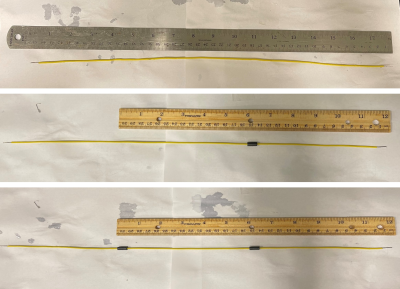 |
161 |
Use of Magnetic Materials to Mitigate RF-induced Heating in
Active Implantable Medical Devices with 1.5T MRI
Md Zahidul Islam1,
Ananda Kumar2,
Jianfeng Zheng1,
and Ji Chen1
1Univ of Houston, Houston, TX, United States, 2FDA, Silver Spring, MD, United States Keywords: Safety, Safety The effect of ferrite magnetic beads to suppress the induced currents on a straight wire active implantable medical devices (AIMDs) lead was investigated. Leads with one, two and no ferrite beads were studied experimentally and using numerical simulations. The application of ferrite beads on the leads significantly reduced induced currents, and thus heating on experiments outside the MRI scanner. In the MRI magnet no significant reduction in heating was observed due to magnetic saturation of the ferrite beads. Suitable magnetic material for current suppression needs to be developed for application in MRI scanners. |
|
2864. |
162 |
RF-induced heating of interventional devices at 0.55T
Ali Caglar Özen1,
Maximillian Russe2,
Thomas Lottner1,
Simon Reiss1,
Sebastian Littin1,
Maxim Zaitsev1,
and Michael Bock1
1Division of Medical Physics, Department of Radiology, University Medical Center Freiburg, Freiburg, Germany, 2Department of Radiology, University Medical Center Freiburg, Freiburg, Germany Keywords: Safety, Interventional Devices, Low Field, RF-induced heating Low-field high-performance MRI systems at 0.55T are expected to cause less RF heating in conventional interventional devices compared to clinical 1.5T or 3T systems, which would facilitate MR-guided interventions significantly. Here we systematically evaluate the safety of intravascular devices through high-resolution electric field mapping, transfer function measurements, and realistic device trajectories from vascular models. Furthermore, the effects of patient size and positioning, target organ (liver and heart), and transmit body coil type are tested at a low-field RF test-bench for 6 commonly-used interventional devices (two guidewires, two catheters, an applicator and a biopsy needle). |
|
2865.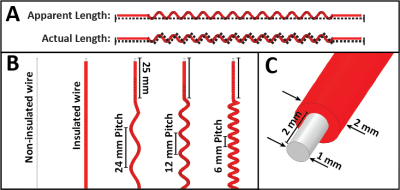 |
163 |
Is MR-induced RF heating around implanted leads lower at 0.55 T
than 1.5 T? Not necessarily.
Pia Panravi Sanpitak1,
Bhumi Bhusal1,2,
Jasmine Vu1,2,
and Laleh Golestanirad1,2
1Department of Radiology, Feinberg School of Medicine, Northwestern University, Chicago, IL, United States, 2Department of Biomedical Engineering, McCormick School of Engineering, Northwestern University, Evanston, IL, United States Keywords: Low-Field MRI, Low-Field MRI, Simulations Low-field MRI systems have been advertised as “safe” for patients with implants – but is this true? In a series of systematic simulations, we looked at implants with varied length, amount of coiling, and insulation during RF exposure in both 0.55 T and 1.5 T MRI environments. We found that both the actual and apparent length of the implant can significantly impact heating. There are several cases where heating is substantially higher at 0.55 T than 1.5 T, suggesting that no broad claims should be made, and these factors need to be carefully considered before scanning a patient. |
|
2866.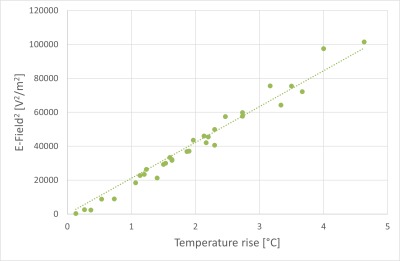 |
164 |
New System, New Approach: Fasten up transfer function validation
measurements, prove of concept
Finya Ketelsen1,2 and
Gregor Schaefers1,3
1MRI-STaR - Magnetic Resonance Institute for Safety, Technology and Research GmbH, Gelsenkirchen, Germany, 2TU Dortmund University, Dortmund, Germany, 3MR:comp GmbH, Testing Service for MR Safety & Compatibility, Gelsenkirchen, Germany Keywords: Safety, Safety, Implants, RF-induced heating The novel open 64 MHz linear exposure system offers new possibilities for the test process of active implants for RF-induced heating as a safety issue. This study proves the concept, that the measurements for the validation process of the transfer function, which models the electric behavior of an active implant, could be accelerated from hours of precise work to minutes without any rearranging. Because the system is open, there is significantly more space than in a birdcage coil and the object and measuring probe can be mounted to a movement system, that can access the whole phantom. |
|
2867. |
165 |
Comparison of the electric field and its line integral along the
lead of a device across five different RF transmit coils
Lydia J Bardwell Speltz1,2,
Seung-Kyun Lee3,
Yunhong Shu1,
Matt Tarasek3,
Joshua D Trzasko1,
Thomas KF Foo3,
and Matt A Bernstein1
1Department of Radiology, Mayo Clinic, Rochester, MN, United States, 2Mayo Clinic Graduate School of Biomedical Sciences, Rochester, MN, United States, 3GE Global Research, Niskayuna, NY, United States Keywords: Safety, Safety We introduce a method to calculate lead-tip voltage for implanted devices by considering 1) the individualized lead path extracted from X-ray-based images, 2) the incident electric field per unit B1+rms derived for the RF transmitter and a digital human body model, 3) the complex RF wavenumber in an insulated conductor derived from antenna theory. T/R coil transmitters in whole-body at 1.5T and 3.0T were considered, as well as a head coil on a compact 3T. Based on leads in 10 subjects, the results show the compact 3T produces less lead tip voltage than whole-body T/R coils. |
|
2868.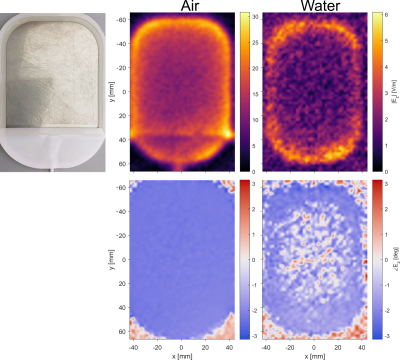 |
166 |
RF Safety Measurements of External Defibrillator Electrodes:
E-Field and Temperature Mapping
Simon Reiss1,
Ali Caglar Özen1,
Thomas Lottner1,
and Michael Bock1
1Division of Medical Physics, Department of Radiology, University Medical Center Freiburg, Freiburg, Germany Keywords: Safety, Safety Currently, no external defibrillation system is available that is labeled MR safe. To create an MR safe device heating induced by the electrodes that are attached to the patient needs to be prevented. In this study, we propose a setup for high resolution RF E-field mapping of commercially available defibrillation electrodes and show that this setup can be used to precisely detect hot spots. At these hot spots, we then perform temperature measurements within a 1.5T to assess the MR safety of the electrodes. |
|
2869.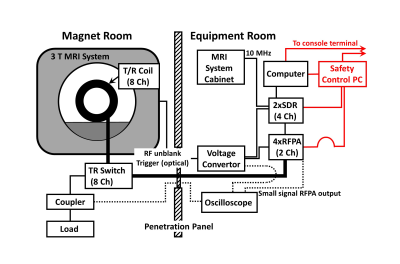 |
167 |
A Modular Parallel Radiofrequency Transmission System Platform
for MRI Safety Investigations at 3 T
Benson Yang1,
Fred Tam1,
Maryam Arianpouya2,
Cathleen Leone1,
Vicki Li1,
Jason Rock2,
and Simon Graham1,2
1Physical Sciences, Sunnybrook Research Institute, Toronto, ON, Canada, 2Medical Biophysics, University of Toronto, Toronto, ON, Canada Keywords: RF Arrays & Systems, New Devices Parallel radiofrequency transmission (pTx) continues to show great promise in resolving MRI challenges at higher magnetic field strengths. Commercial pTx MRI systems can be very costly with limited system channel count options. This work presents the current state of an 8-channel pTx MRI system with expansion flexibility up to 32-channels that is based on software-defined radio technology. |
|
2870.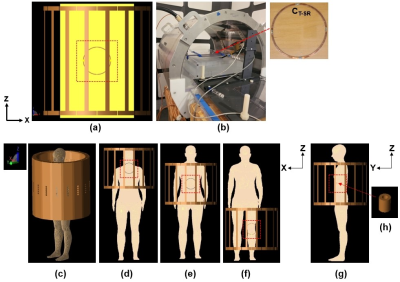 |
168 |
A New Method to Improve RF Safety of Implantable Medical Devices
using Inductive Coupling at 3.0T MRI
Bu S Park1,
Joshua Guag2,
Sunder Rajan2,
and Brent McCright3
1FDA, Silver Spring, MD, United States, 2Division of Biomedical Physics (DBP), FDA, Silver Spring, MD, United States, 3Division of Cellular and Gene Therapies (DCGT), FDA, Silver Spring, MD, United States Keywords: Safety, Electromagnetic Tissue Properties This study describes a new method to improve RF safety of implantable medical devices located outside of the imaging region by using a secondary resonator (SR) to reduce electric fields and corresponding specific absorption rate (SAR) during MRI. The SR is designed to produce opposing electro-magnetic fields (EM-fields) compared to the EM-fields made by a body coil at 3.0T. This study was performed using numerical simulations with ASTM phantom and human models, and corresponding experimental verifications with the ASTM phantom. Keywords: RF safety, secondary resonator |
|
2871.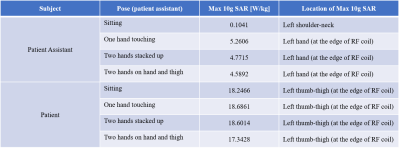 |
169 |
RF exposure of patient assistants at a low-field open MRI system
Sukhoon Oh1,
Seon-Eui Hong2,
Hyung-Do Choi2,
Dongwoo Chang3,
Kiseong Kim4,
and Sangwoo Kim5
1Korea Basic Science Institute, Cheongju, Korea, Republic of, 2Electronics and Telecommunications Research Institute, Daejeon, Korea, Republic of, 3Chungbuk National University, Cheongju, Korea, Republic of, 4BioBrain, Inc., Daejeon, Korea, Republic of, 5Daewon University College, Jechoen, Korea, Republic of Keywords: Safety, Safety Numerical investigations on the safety of patient assistants exposed to a 1.2T open MRI are performed at different poses of patient assistants (including wearing latex gloves), because current regulations are concerned with only patient RF safety. Compared with the patient, up to 29.8% of the patient 10-gram SAR was observed in the patient assistant. To prevent possible RF hazards of a patient assistant during MRI scans, certain clauses regarding the patient assistant’s poses or wearing gloves must be added to the existing MRI screening forms. |
|
2872.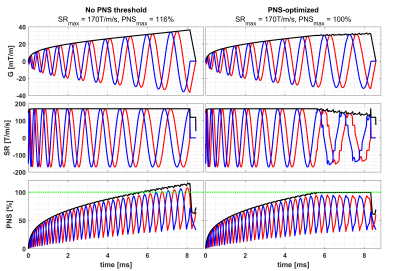 |
170 |
Consideration of peripheral nerve stimulation in the
optimization of spiral k-space trajectories
Oliver Schad1,2,
Tobias Wech1,
and Herbert Köstler1
1Department of Diagnostic and Interventional Radiology, University Hospital Würzburg, Würzburg, Germany, 2University of Würzburg, Experimental Physics 5, Würzburg, Germany Keywords: Gradients, Safety, Peripheral Nerve Stimulation The algorithm we present in this work designs variable density spiral (VDS) trajectories and their respective gradient time courses based on the Stanford VDS-tool. In addition to hardware limits (maximum gradient strength and slew rate) a PNS threshold based on the SAFE-Model is introduced. |
|
2873.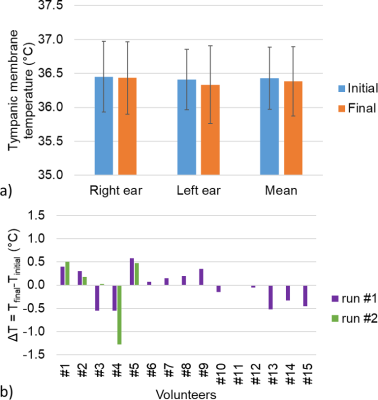 |
171 |
Physiological variability of the tympanic membrane temperature
as an RF safety metric assessment
Caroline Le Ster1,
Mikhail Kozlov2,
Alexandre Vignaud1,
and Nicolas Boulant1
1University of Paris‐Saclay, CEA, CNRS, BAOBAB, NeuroSpin, Gif-sur-Yvette, France, 2Department of Neurophysics, Max Plank Institut for Human Cognitive and Brain Sciences, Leipzig, Germany Keywords: Safety, Thermometry RF exposure during MR exams induces heating of the exposed tissues. Measurement of tympanic membrane temperature with an infrared sensor has been used to estimate non-invasively the global RF-induced temperature rise. In this study, the tympanic membrane temperature was measured before and after having the volunteers lying for 15 minutes with earplugs with neither an RF nor a static magnetic field. Large physiological variations of temperature rise were observed across the volunteers after this dummy “exposure”, showing the low reliability of this metric to measure small temperature rises, that make it problematic for RF-induced temperature rise estimation. |
|
2874. |
172 |
MR conditionality of two MR Conditional DBS ipsilateral implants
with separate IPGs
Louai Aldayeh1,
Mizan Rahman1,
and Ross Venook1
1Boston Scientific Neuromodulation, Valencia, CA, United States Keywords: Safety, Safety Previous investigations of RF-induced heating of multiple implants (active as well as passive) have shown that heating of an implant can be impacted by the presence of a separate neighboring implant. This work assessed to which extend this phenomenon is present for the limited scope of two separate MR Conditional ipsilateral DBS implants, one on one side of the body, and another on the other side. Both, RF-induced heating and voltage injection level into the IPG were assessed. A variety of DBS lead configurations, and clinically relevant distances in-between the two separate implants, were thoroughly assessed for a data-driven conclusion. |
|
2875.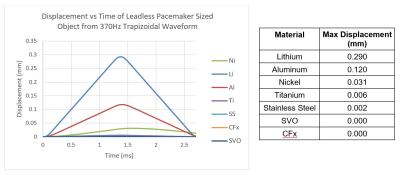 |
173 |
MRI Gradient Induced Vibration of Leadless Pacemakers
Michael Childers1,
Dorab Sethna1,
and Shiloh Sison2
1Abbott, Sylmar, CA, United States, 2Abbott, Sunnyvale, CA, United States Keywords: Safety, Safety, Implants Simulations were performed to assess potential gradient induced vibration of leadless pacemakers. Results of the evaluation showed leadless pacemakers sized objects, made from commonly used conductive materials, generated very small vibrations (all less than 0.3mm in displacement) when exposed to conservative gradient induced vibration safety test conditions per ISO/TS 10974. These calculated displacements are negligible in comparison to the interacting displacements between a typical leadless pacemaker and cardiac tissue through each cardiac cycle. As such, the risk of leadless pacemaker gradient induced vibration tissue damage is minimal and assessments for this hazard per ISO/TS 10974 may not be necessary. |
|
2876.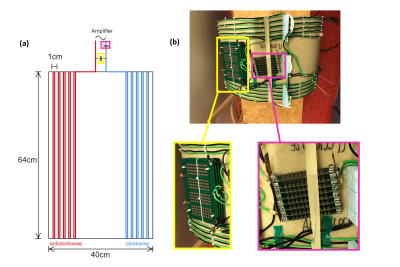 |
174 |
A novel PNS measurement setup for body gradient coils at an
ultrasonic driving frequency of 20kHz
Michael JB McGrory1,
Edwin Versteeg1,
Jeroen CW Siero1,2,
and Dennis WJ Klomp1
1Radiology, University Medical Center Utrecht, Utrecht, Netherlands, 2Spinoza Center for Neuroimaging, Amsterdam, Netherlands Keywords: Gradients, Gradients Large dB/dt swings in gradient coils can induce peripheral nerve stimulation (PNS) in the human body. This limits the slew rates used in whole-body MRI reducing scan speeds and spatial resolution. Ultrasonic head gradients can enable fast and silent imaging, however extension to whole-body gradients is challenging due to the required larger dB/dt swings. In this work, we present a body gradient coil which can be used to investigate PNS induction at an ultrasonic driving frequency of 20kHz. |
|
2877.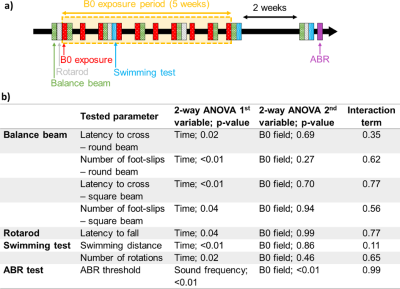 |
175 |
Behavioural and functional assessment of mice inner ear after
chronic exposure to an ultra-high static magnetic field of 11.7T
or 17.2T.
Caroline Le Ster1,
Erwan Selingue1,
Roseline Poirier2,
Jean-Marc Edeline2,
Sébastien Mériaux1,
and Nicolas Boulant1
1University of Paris-Saclay, CEA, CNRS, BAOBAB, NeuroSpin, Gif-sur-Yvette, France, 2University of Paris-Saclay, CNRS, NeuroPSI, Saclay, France Keywords: Bioeffects & Magnetic Fields, Animals High static magnetic (B0) fields are known to induce a transient disturbance of the inner ear. Recently a study demonstrated long-term behavioural effects in mice chronically exposed to a B0 field of 16.4T. In the current study, mice underwent chronic B0 exposure at 11.7T or 17.2T and longitudinally performed behavioural tests over the study. An auditory brainstem response (ABR) test was performed at the end of the full exposure period to assess inner ear properties. Despite the transient disturbance of mice inner ear observed immediately after B0 exposure, no short-term or long-term alteration was detected with behavioural or ABR tests. |
|
2878.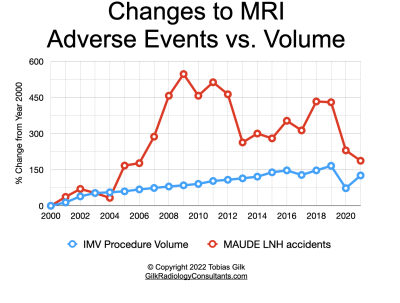 |
176 |
Working Harder at MRI Safety, But Getting Poorer MRI Safety
Results.
Tobias Gilk1,2
1Gilk Radiology Consultants, Overland Park, KS, United States, 2RADIOLOGY-Planning, Kansas City, MO, United States Keywords: Safety, Safety US data suggests that MRI adverse events are growing at a rate of nearly 3x the rate of MRI examinations. While MRI accidents and injuries remain infrequent, the long-term trend of significant growth in MRI adverse events highlights needs for vigilance in MRI safety. |
|
2879.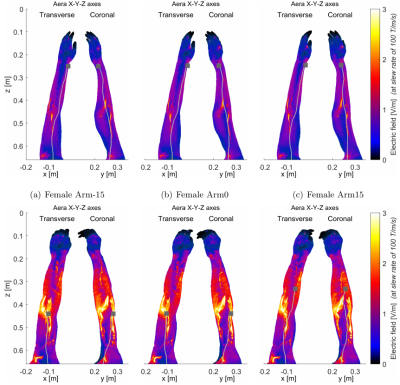 |
177 |
Influence of arm rotations on peripheral nerve stimulation
thresholds for the interventionalist in MR guided procedures
Feng Jia1,
Sebastian Littin1,
Philipp Amrein1,
Maximilian Frederik Russe2,
and Maxim Zaitsev1
1Division of Medical Physics, Department of Radiology, University Medical Center Freiburg, Freiburg, Germany, Freiburg, Germany, 2Department of Radiology, University Medical Center Freiburg, Freiburg, Germany, Freiburg, Germany Keywords: Safety, Safety, PNS Simulation Simulation of peripheral nerve stimulation of MRI gradient coils for rotated arms of an interventional radiologist. The arm rotation has a direct influence on the site of stimulation in the arm. |
|
The International Society for Magnetic Resonance in Medicine is accredited by the Accreditation Council for Continuing Medical Education to provide continuing medical education for physicians.